Samsung Q1 Ultra Mobile PC Review
Samsung Q1 Ultra Mobile PC
Samsung thinks that the Q1 could change the face of mobile computing, but is it change for the sake of it?
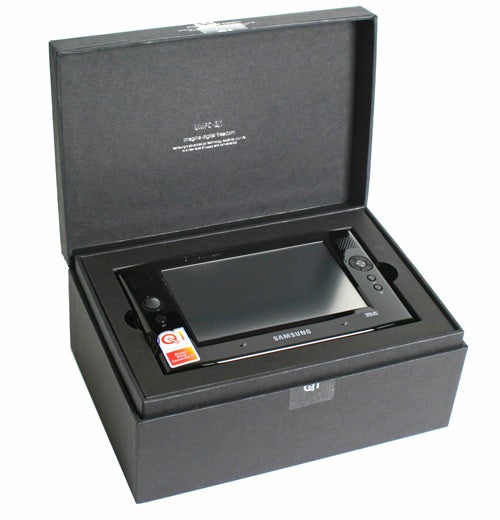
Verdict
Key Specifications
- Review Price: £799.00
I have to admit that I’m not convinced that the Ultra Mobile PC (UMPC) category of devices has any business existing. From the minute I saw prototypes of these devices start to appear, the UMPC just appeared to be a solution to a problem that didn’t really exist. Is there really a need for a device that sits between an ultra-portable notebook and a fully featured PDA? I’m not so sure. But despite my lack of faith in the UMPC, I am a real sucker for cool gadgets so I was keen to get my paws on a Samsung Q1 despite my reservations.
The first thing that struck me about the Q1 was the packaging. Samsung has really pushed the boat out to make the Q1 look good even when it’s in the box. Much like the old Apple iPod cube shaped boxes, the Q1 packaging looks sleek, stylish and expensive. But since you can’t judge a book by its cover, it’s good to know that the Q1 itself looks even better than the box that it ships in.

The general consensus around the TrustedReviews office is that the Q1 looks like a PSP on steroids. The glossy black finish, widescreen display and what looks like a PSP analogue stick on the left all conspire to create that oversized PSP effect. The overall image of the Q1 is one of a high-end consumer electronics device, rather than a PC and I guess the general idea is that it’s a bit of both. Weighing in at 779g and measuring only 227 x 140 x 27mm (WxHxD) the Q1 is large and heavy compared to a Windows Mobile device, but smaller and lighter than even the most svelte ultra-portable notebook.
Inside the Q1 is an Intel Celeron M running at 900MHz, along with 512MB of memory. The Q1 will accept up to 1GB of memory, but you’d have to dump the 512MB SODIM if you wanted to upgrade. The 40GB hard disk is hardly capacious by notebook standards, but Samsung is limited to a 1.8in model due to the size of the Q1. Wireless connectivity is well catered for with both 802.11b/g Wi-Fi and Bluetooth onboard, allowing you to get connected via a hotspot, or through a Bluetooth enabled mobile phone.
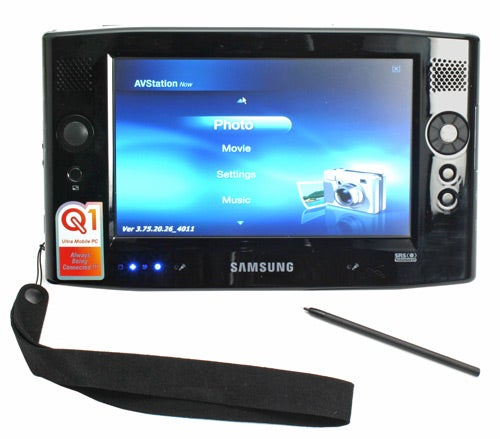
The first problem I encountered with the Q1 was controlling the pointer. You see with the analogue stick on the left, my first assumption was that I would use this to move the pointer, but this is not the case. You use the stylus and the touch screen for pointer manipulation, while the stick acts like the cursor keys on a keyboard. It’s a shame though, because using the stick to move the pointer just seems so natural, and in my opinion would make the Q1 an easier device to use.
The 7in screen is a high quality affair with even lighting and reasonably vivid colours – I say reasonably, because being a touch screen, the display isn’t quite as punchy as it otherwise would be. The native resolution is 800 x 480 but there is a button below the joystick that will switch through 800 x 600 and 1,024 x 600 resolutions. However, since these higher resolutions are scaled, the image produced is fuzzy – unless you’re absolutely desperate for more desktop real estate, you should stick with the native resolution.
Considering that I’ve seen 10.6in widescreen notebook displays sporting a 1,280 x 768 resolution, I would have preferred for the Q1 to have a 1,024 x 600 native resolution. I accept that this would probably push the price up a bit, but considering that the majority of web sites are based on a 1,024 pixel wide template, one of the main uses of the Q1 would be greatly enhanced.
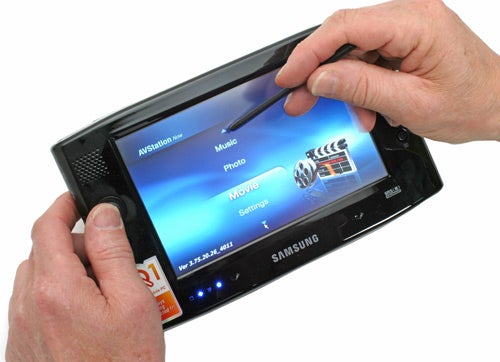
To the right of the screen is a four-way rubber pad for activating four user definable buttons. I’m all for customisation and this approach works very well, just like programmable hot keys on a notebook. Below the four-way pad is a Return button and below this is a Menu button.
The Menu button is very useful and brings up a multitude of configuration options like switching the Wi-Fi on and off, turning the sound off and changing the brightness level. A rather odd inclusion on this menu is an option to turn “Etiquette Mode” on and off – the reason why I call this option odd is because I can’t figure out what it’s supposed to do and there’s absolutely no mention of it in the user manual.
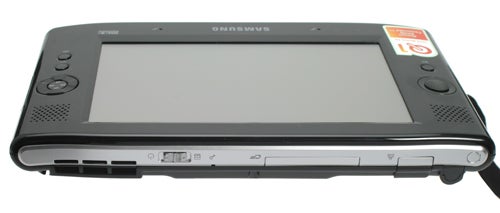
Also on the Menu list is a screen rotation button. With this you can switch the orientation of the screen through 360 degrees, in 90 degree steps. Unfortunately the joystick orientation doesn’t alter as the display rotates, so if you like navigating menus using the joystick, things start to get a bit confusing when you flip into portrait mode.
The chassis is littered with ports and connectors. On the right hand side you’ll find the power socket, a USB 2.0 port and a D-SUB port hidden behind a plastic flap. On the left is another USB 2.0 port, a headphone jack, a volume control, a hold switch and a connector for powering an external optical drive. The hold switch is a clever idea because not only does it deactivate all the buttons on the Q1, it also completely locks the touch screen.
Also, you’ve probably noticed that the Q1 has a headphone socket but no microphone socket. This is because there are two array microphones embedded into the front fascia, just below the screen. These do work surprisingly well and allow for VoIP functionality without the need for a headset. That said, if you did wish to use a headset, the lack of mic port would mean that you’re limited to a USB solution.
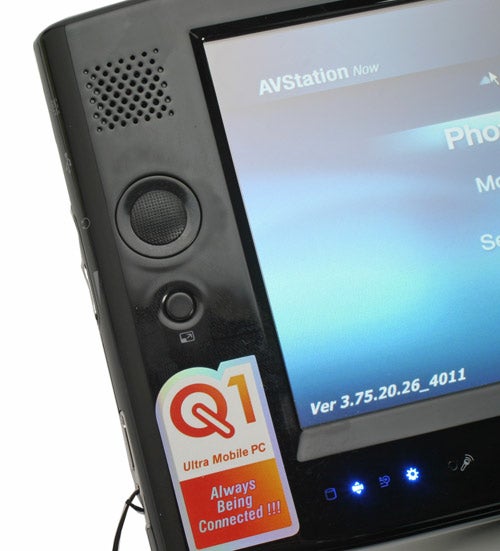
On the top is the power switch, a network port for the integrated 10/100 Ethernet controller and a CompactFlash slot. Samsung lists the CompactFlash slot as Type I only, which means that it shouldn’t accept an IBM MicroDrive. However, I stuck a 1GB MicroDrive into the slot and it worked fine – the problem isn’t that a Type II device doesn’t fit, it’s that there’s no eject button, which makes removing a MicroDrive a bit tricky as it doesn’t have the ridge on the edge like a Type I device.
Interestingly the throughput from the CompactFlash slot seemed to be somewhat below par. Now, when I was chatting to Sandra about the Q1 she said that she encountered stuttering problems when listening to MP3 files on a CompactFlash card. I didn’t have any problems like that, and in fact I have happily watched DivX video directly from a CompactFlash card in the Q1 with no stuttering at all. However, when I tried copying a 350MB video file from a card to the Q1’s internal hard disk, it took over eight minutes, even though I was using a fast SanDisk Ultra II card. Considering that the same copy took a fraction of the time using a USB 2.0 card reader, I can only assume that the interface on the internal CF reader is somewhat limited.
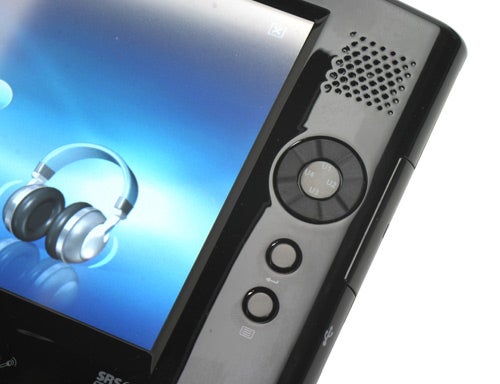
Unlike the OQO model 1, there’s no slide out keyboard with the Q1, it’s more akin to the Sony Type U. In fact in reality the Sony Type U could probably be considered a UMPC despite being launched well before the invention of the category. Without a keyboard you’re left to using the stylus when it comes to text input. The most obvious and simple method is to stab at a virtual keyboard, which works well enough for tapping in URLs or sending short emails, but you wouldn’t want to write a long document this way.
Another way to enter text is via handwriting recognition. If you’ve been frustrated by handwriting recognition in the past, erase those experiences from your memory. The handwriting recognition on the Q1 is not only surprisingly accurate, but it’s also very fast. The Q1 managed to consistently decipher my ridiculous scrawl and even Benny’s scratchings were translated. However, as with the virtual keyboard, I wouldn’t want to write a long document using this method.
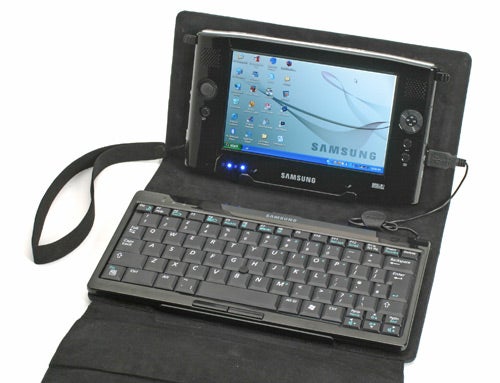
Hereby lies one of the big problems with the Q1. The UMPC is being marketed as an alternative to a full size notebook, but when it comes to text entry it’s a far from convenient tool. In fact you’ve probably already read reviews criticising the Q1 for this very point, but I’m not going to do that. You see after meeting with Samsung last week, I walked away in the knowledge that the USB keyboard travel pack will now be bundled with the Q1 at no extra cost.
The USB keyboard takes the Q1 to a different level, making it a viable mobile workstation for someone like myself. The USB keyboard itself is first rate and I find it as easy to type on as a good notebook keyboard. There’s a trackpoint for pointer manipulation and two selector buttons just below the Spacebar. But the real beauty of the USB keyboard travel pack, is that it’s just that, a travel pack. Constructed from suede, the travel pack has clips and mounts that hold the Q1 in place and similar brackets to hold the keyboard in place. There’s a flip out stand that allows the Q1 to stand upright, giving you a sort of notebook ergonomic setup. There’s even a Velcro clasp to hold the excess USB cable and keep things tidy. When you’re not using the setup, you simply fold the whole thing up, leaving you with a bit of kit about the size and weight of an ultra-portable notebook.
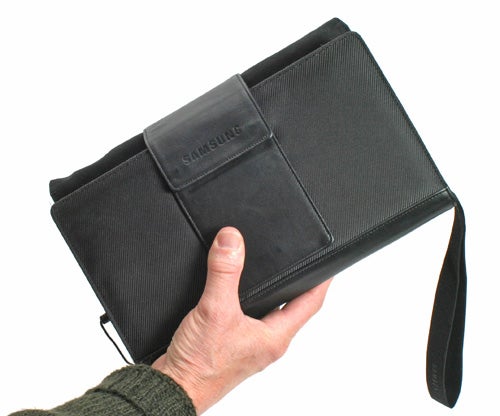
But even with the excellent travel pack, there is one major problem that would stop me from considering the Q1 as an alternative to say, a Sony TX2XP – battery life. I found that I was lucky to get two hours out of the Q1 with Wi-Fi enabled and this is just not good enough for a device that you take out and about with you. I need to know that I can go out for the day and use my notebook whenever I need to, the Q1 just can’t rise to that challenge.
Despite its obvious limitations there are certain aspects of the Q1 that have really grown on me, like the fact that it makes casual web browsing so easy. When I say casual web browsing, I mean lounging on the sofa with the TV on, while catching up on your favourite web sites. For instance, my wife has taken to using my notebook to browse the web because our four month old daughter makes it difficult for her to sit in front of a desktop machine for any length of time. As an experiment I handed her the Q1 and snatched the notebook away from her – within seconds she was happily browsing the web on the Q1 and had no desire to switch back to the larger and heavier notebook.
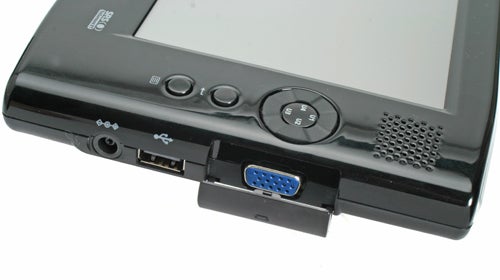
I was also very impressed with the video playback performance on the Q1. Having just watched the last two episodes of 24 on this little machine, I was surprised at how immersive the experience was. The integrated speakers are good enough for watching movies and TV shows, but you’re still best off plugging a set of headphones in to get the best effect. The Q1 does lose a little detail in dark scenes, but this is something that most portable media players fall foul of, although the touch screen probably exacerbates it slightly. The Q1 also has a mode called AV Now, which allows you to playback media without having to boot into Windows, but I couldn’t get any video other than basic WMV files to work using this method.
With a price of £799 including VAT the Q1 is a lot cheaper than the OQO model 1 or an ultra-portable notebook like the Sony TX2XP. That said, whether it’s worth the money is still open to debate – like the OQO model 1, the Q1 is an undoubtedly desirable product, but do you actually need one?
Samsung has definitely done a good job with the Q1, especially when you consider that this is a first generation UMPC. The ease of browsing the web while relaxing on your sofa or sitting out in the garden is a great feature, and the bundled USB keyboard makes doing serious work (like writing this review) a breeze. Unfortunately the low screen resolution, and more importantly the very poor battery life spoil the party.
If Samsung can improve the battery life on the next generation of Q1 it will make it an altogether more compelling prospect. Considering that the Korean giant has already announced a version of the Q1 with a 32GB solid state disk at its core, I could get my wish, and get lightning fast I/O thrown into the bargain. But before you get too excited, the SSD version of the Q1 is set to cost $2,430 in the US, so it will be far more expensive than this Q1 if it appears in the UK.
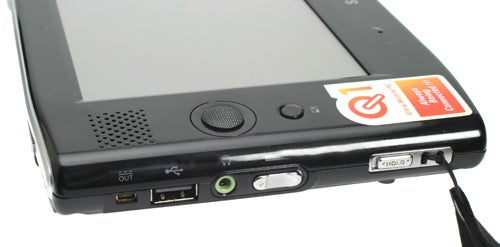
”’Verdict”’
Top marks to Samsung for creating a beautifully designed and constructed ultra mobile PC. The Q1 really does look the part and in many ways it has the ability to back up its stylish appearance. The inclusion of the USB keyboard travel pack is more of an obvious necessity than a good idea, making the Q1 a usable mobile computer. General browsing and even watching video is a joy on this little machine, but you really want to do these things on the move, without being tethered to a power socket.
Ideally I’d like to see the next Q1 (the Q2 maybe?) ship with a higher resolution screen – preferably 1,024 pixels wide – and better battery life. Considering that Sony can squeeze seven hours out of the TX2XP, I have no doubt that Samsung can manage better battery life in the next Q1, but as the current Q1 stands, it’s not the ultimate mobile computer that it should be.
How we test laptops
Unlike other sites, we test every laptop we review thoroughly over an extended period of time. We use industry standard tests to compare features properly. We’ll always tell you what we find. We never, ever, accept money to review a product.
Trusted Score
Score in detail
-
Performance 7
-
Value 8
-
Features 7

